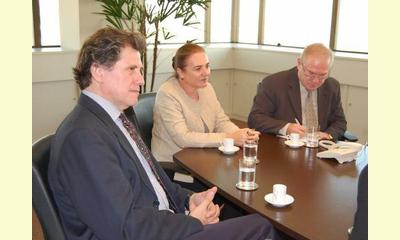|
|
Restorative Justice for Children in Brazil
an article by Judge Leoberto Brancher, AJURIS Magistrate's School, Brazil
I come from Brazil. I've been a Judge for 23
years. I dedicate all my career, and also my
volunteer work, to Children and Youth Justice. In
my experience, the diversionary procedures became
more relevant, and took on a new meaning, after I
learned about the restorative justice paradigm.
Before that, we focused just on avoiding young
people from being exposed to the impacts of a
coercive system. . .

Left to right: Judge Brancher, Attornies Simone Mariano da Rocha and Afonso Armando Konzen, members of the Commission for the Study of Restorative Justice
click on photo to enlarge
It is surprising to the people - and it is
subversive to the system - when a judge has the
possibility of opening the door of his courtroom
of bringing a facilitator in, and giving a new
direction to the lives of the people involved in
that conflict. In my Court we have such a door,
which our facilitators call , affectionately, "the
door of hope". A service which allows, in real
time, an interaction among the Judge, the other
judiciary professionals in the proceedings, the
stakeholders, the witnesses and the services
professionals can also become a kind of powerhouse
to spread Restorative Justice into other
application contexts. . .
Brazil incorporated the norms of the UN Convention
on Children's Rights, the Beijing Rules and the
Riyadh Guidelines to its national legal code with
a new law in 1990. According of this law,
children under twelve years old don't have any
kind of penal responsibility. Between twelve and
eighteen, they will respond by their crimes with a
special kind of sanction, under the jurisdiccion
of the Juvenile Justice System. This new law
opened a space for a vigorous social movement in
favor of Children's rights. Its implementation
has produced very important cultural and
institutional changes.
It was in that context that the ideas on Restorative
Justice began to be heard in Brazil.
Brazil is a rich country, but we face very serious
social and economical inequality. Those
inequalities result in conflict, social disorder,
generalized crime and violence. That destructive
social context echoes in the Children and Youth
Justice environment. Some of our main concerns
involve the following problems:
(1) The instability at schools regarding
coexistence, which has been undermining the learning
process,
(2) The disruption of families where there are drug-
addicted adults, particularly crack addicts, who are
negligent or impose maltreatment on their children,
(3) Drug-addicted youth, most notably crack
addiction, and their frequent involvement with
trafficking and other related crimes,
(4) The urban gangs through which the youth assert
their identity and spend their time vandalizing,
involved with disorders and violent confrontations,
(5) The escalation of the serious crimes profiles
in which youth take part, their involvement in
armed robbery, homicides, murders with intention
to rob are becoming more and more common.
Editor's Note: This is a abridged version of a
speech by Brancher to a conference in Bali
Indonesia, June 2013.
This article is continued in the discussion section.
|








|
DISCUSSION
Question(s) related to this article:
Coninuation of Restorative Justice in Brazil,
* * * * *
LATEST READER COMMENT:
The following is continued from the article Restorative Justice in Brazil.
Professor Howard Zehr has taught us that, the greater the pain, the greater the restorative potential the case will have. And it is in that painful environment that Restorative Justice has flourished among us, like a lotus flower that blooms from the mud. We face a tragic reality to which we must respond with wisdom and enlightenment.
The first texts on Restorative Justice in Brazil appeared in 1999. They were disseminated throughout the country by the Children and Youth Magistrates, Prosecutors and Public Defenders Brazilian Association.
In 2005, Restorative Justice was officially introduced in Brazil THROUGH a partnership between our Ministry of Justice and UNDP which made three pilot projects possible. All of them led by judges and having their own Courts as the basis to implement the practices.
I was responsible for one of those projects which took place in Porto Alegre, capital city of the State of Rio Grande do Sul, the southernmost State in Brazil, bordering Uruguay and Argentina. That Project is named "Justice for the 21st Century" and took on the responsibility for testing and disseminating Restorative Justice practices in the resolution of conflicts and violence involving children and adolescents. It is an initiative of the Rio Grande do Sul Judges Association and of the Magistrates' School with the support from our State Court of Justice.
The fact that we are Judges who volunteered for the project, with the support of our official institutions, gives us much credibility and makes the articulation with other institutions easier. At present it has made it easier for the Restorative Justice process to be absorbed by the Justice System institutions themselves.
The Magistrates' School has been our headquarters for the Restorative Justice courses. . ...more.

|
|









